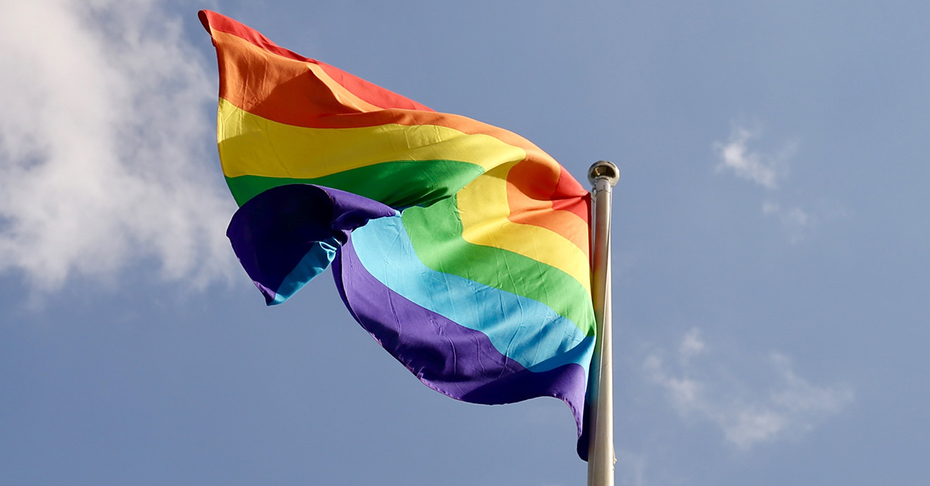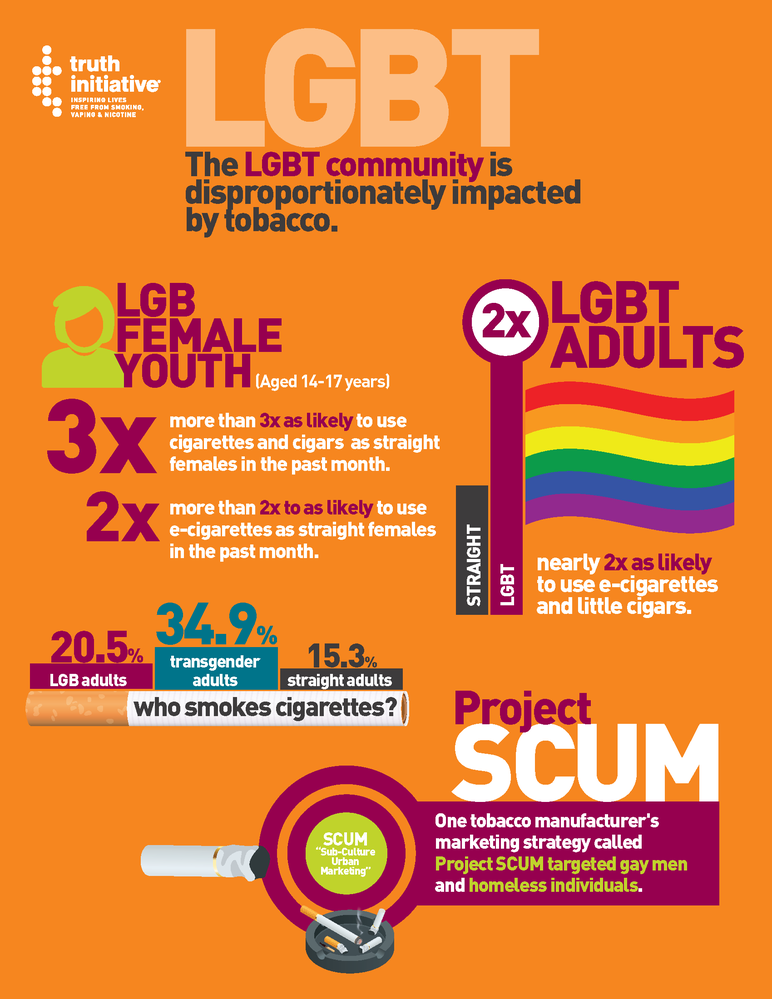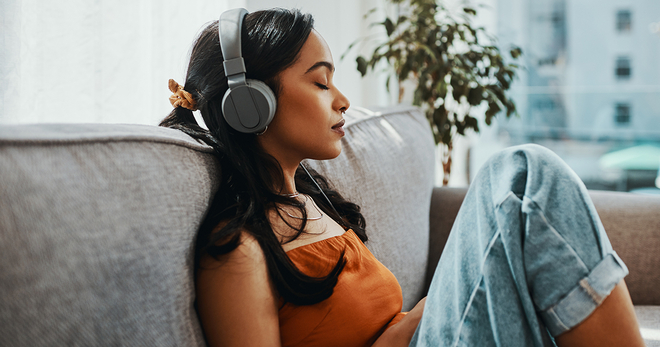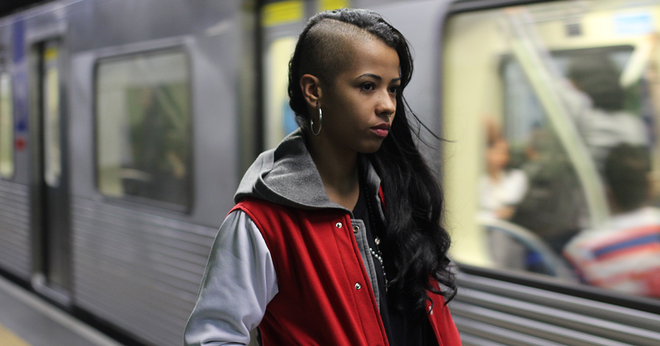Tobacco use in LGBT communities
LGBT individuals may experience disparities that stem from social stigma and discriminatory treatment. On top of that, there is a different kind of disparity in the LGBT community that is often overlooked: disproportionately high tobacco use rates.
Overall, lesbian, gay and bisexual adults* smoked cigarettes at rates significantly higher than straight adults and were nearly twice as likely to use e-cigarettes and little cigars — trends due in part to targeted marketing by Big Tobacco. Transgender youth currently used tobacco products at higher rates than cisgender youth, including 4X higher cigarette use and 3X higher e-cigarette use. For years the tobacco industry has made efforts to appeal to LGBT consumers through things like targeted advertisements in LGBT press, cigarette giveaways, and free tobacco industry merchandise. Today, the LGBT community is among the hardest hit by tobacco.
TOBACCO USE RATES IN THE LGBT COMMUNITY
Research documenting the health disparities among LGBT individuals is growing, but there are still limited national data available regarding tobacco use among the LGBT community. Indeed, the most current national data for LGBT youth and adult tobacco use rates are from 2016, emphasizing the urgent need to improve research in this community. The data that are available indicate that the LGBT community is disproportionately impacted by tobacco.
TOBACCO USE TRENDS AMONG SEXUAL MINORITY YOUTH
- LGB females between 14-17 reported using one or more tobacco products at 2.5X the rate of straight females. Similarly, LGB female youth reported using cigarettes and cigars at more than 3X and e-cigarettes at more than 2X the rate of straight females in the past month.
- Transgender youth between 14-17 reported recent use of more than one tobacco product at nearly 3X the rate of cisgender youth. Tobacco products included e-cigarettes, cigarettes, cigars, hookah, and smokeless tobacco.
- Transgender youth reported using tobacco products at much higher rates compared to cisgender youth, with 3X the rate of using e-cigarettes, 4X the rate of using cigarettes and 3.5X the rate of using smokeless tobacco compared to cisgender youth.
- In addition to using tobacco products at higher rates, youth sexual minorities were more likely to use tobacco more heavily. For LGB girls in grades 9-12, sexual identity disparities in heavy cigarette use — using tobacco more than 20 days out of the past 30 — remained high from 2005 to 2015. Compared to heterosexuals, the odds of lesbians heavily using cigarettes increased from 3.3X in 2005 to 3.7X in 2015. For bisexuals, the odds increased from 4.9X in 2005 to 6.2X to 2015. LGB girls also had higher odds of heavy use compared to heterosexual girls from 2011-2015. Trends were similar with boys — compared to heterosexual boys, odds of heavy use were generally higher among gay and bisexual boys between 2005 and 2015, with the exception of 2015 for gay boys and 2009 for bisexual boys.
TOBACCO USE HIGHER IN ADULT SEXUAL MINORITIES
Overall, more lesbian, gay or bisexual adults smoked cigarettes (20.5%) compared to heterosexual adults (15.3%) in 2016. Gay and bi-sexual men were also more likely than straight men to use cigarettes (23.8% vs 17.3%), as were LGB women compared to straight women (17.9% vs 13.5%). LGB adults were nearly twice as likely to use e-cigarettes and little cigars.
LGBT smokers are significantly more likely to smoke menthol cigarettes: more than 36% of LGBT smokers report that they usually smoke menthols, which are easier to use and harder to quit.
- Transgender adults also had higher odds of currently using tobacco products, including cigarettes, e-cigarettes, and cigars, compared to cisgender adult use of any tobacco product (32.6% vs 23.6%).
- Only 22.4% of cisgender adults reported currently using cigarettes compared to 34.9% of transgender adults. Transgender adults were also about twice as likely to use e-cigarettes and cigars compared to cisgender adults.
TOBACCO MARKETING TOWARD THE LGBT COMMUNITY
Targeted marketing of tobacco products to the LGBT community began as early as the 1990s, when tobacco companies — aware of high smoking rates among sexual minorities — aimed to take advantage of the emerging LGBT market.
Tobacco companies used a multitude of methods to target the LGBT community, including advertising in gay press publications, depicting tobacco use as a normal part of LGBT life, using corporate philanthropy as evidence of its support of the LGBT community, participating in giveaways, increasing advertising, and hosting community outreach efforts (e.g. “LGBT bar nights”) featuring specific cigarette brands.
In 1995, the tobacco company R.J. Reynolds created a marketing strategy called “Project SCUM” (Sub-Culture Urban Marketing) to boost cigarette sales by targeting gay men and homeless individuals with advertisements and displays placed in communities and stores.
Today’s e-cigarette companies have followed suit by supporting LGBT-friendly events, including the e-cigarette company VaporFi’s sponsorship of an annual gay pride festival in Miami, where they encouraged participants to celebrate diversity while on the lookout for VaporFi e-cigarettes.
Decades of advertising efforts targeting the LGBT community appear to have paid off. Compared to straight smokers, LGBT smokers saw or heard about tobacco discounts and e-cigarette ads in the past month at greater rates than non-LGBT smokers. LGBT individuals reported rates of exposure to tobacco couponing messages on video streaming websites like Hulu at rates 3X more likely than straight individuals. Bisexual women were more likely to be exposed to ads for cigarettes, e-cigarettes, and cigars compared to straight women. Males that identified as something else other than gay or bisexual — such as queer, pansexual or had not defined their sexuality — were more likely to be exposed to cigarette ads and e-cigarette ads.

Federal, state and local levels can take important steps to help reduce tobacco use overall, including among the LGBT community.
ACTION NEEDED
The tobacco industry has targeted the LGBT community for decades. Federal, state and local levels can take important steps to help reduce tobacco use overall, including among the LGBT community. Steps include:
- FDA should restrict social media and use of influencers to adult audiences. Further the Federal Trade Commission must ensure that all paid influencer advertisements are declared and clearly indicate the risks associated with nicotine use.
- FDA must remove all flavored tobacco from the market, including menthol cigarettes, flavored cigars and e-cigarettes. We support a permanent ban on flavored tobacco unless a manufacturer can demonstrate three things to the FDA: 1) that a particular flavor helps current tobacco users switch completely to a substantially less hazardous product, 2) it will not lead non-tobacco users, such as youth, to start, and 3) the flavor itself does not increase the risk of harm from using the product. States and localities should also restrict sales of flavored tobacco.
- Ensure access to cessation services and reduce barriers to care for the LGBT community.
- Improve data collection on topics including tobacco use rates, perceptions, disease risk in the LGBT community to ensure a more robust picture of tobacco use among this group.

*Terminology in this document varies and is based on the studies cited. Truth Initiative recognizes that some of these terms are no longer preferred in the LGBT community.
More in targeted communities
Want support quitting? Join EX Program
By clicking JOIN, you agree to the Terms, Text Message Terms and Privacy Policy.
Msg&Data rates may apply; msgs are automated.






